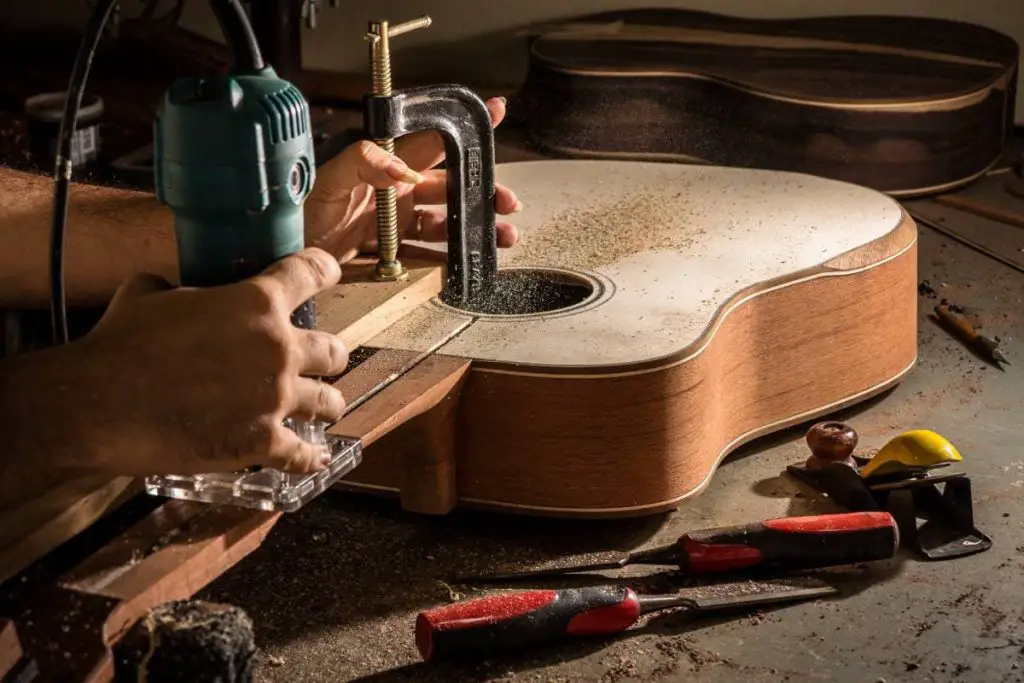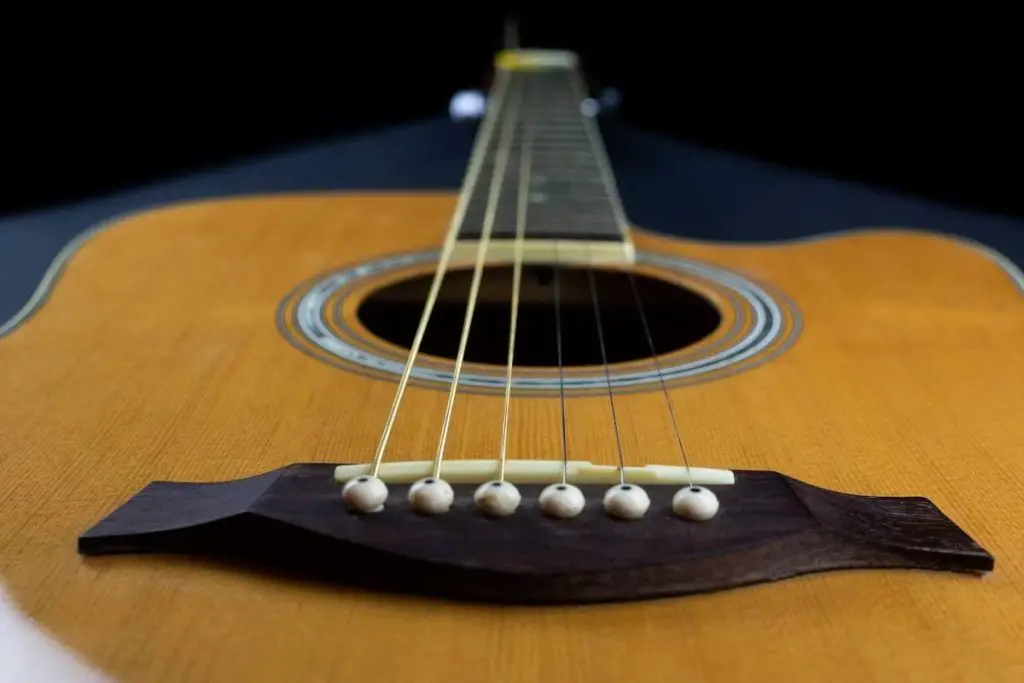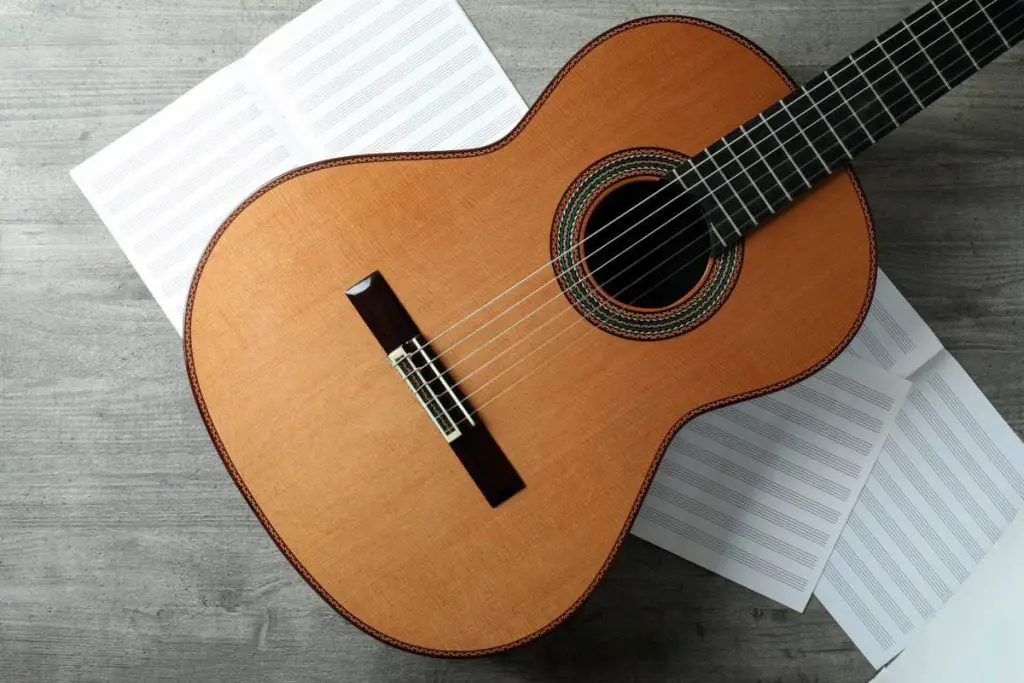Many guitar experts and enthusiasts argue that older guitars create a better tone, sustain, and resonance due to the wood’s natural aging process. However, it’s hard to tell whether that’s a provable fact or just an industry myth, especially considering that, for the most part, only well-made top-tier guitars make it past their 50th birthdays. So, do guitars actually sound better as they age, and if so, why?
Here are nine reasons why acoustic guitars sound better with age:
- Wood becomes harder and more warp-resistant as it ages.
- The glues in older guitars have fully cured.
- Vibrations can make a wood thinner and more flexible.
- Frequent use can break up the sap in the wood.
- Only high-quality guitars last long enough to become old.
- Lamination interferes with the aging process.
- Controlled aging increases resonance and sustain.
- Acoustic guitars do not rely on pickups.
- Sound is subjective.
In the following sections, I’ll dive deeper into what makes acoustic guitars sound better as they age. Let’s get started!
If you want to find out what my recommended guitar gear is, then here is what I recommend on Amazon:
- Fender Cutaway Acoustic-Electric Guitar Bundle (MY FAVORITE GUITAR)
- Snark SN-8 Super Tight All Instrument Tuner (Easiest Tuner I’ve Used)
- 6 String Acoustic Guitar Capo (Best CAPO for quick changes)
- Dunlop Max Grip 1.0mm Nylon Picks (Thick Guitar Pick So You Don’t Lose Grip!)
- Universal Guitar Stand (Cheap & Minimalist Guitar Stand I Recommend)
- Levy’s 2″ Wide Quick Adjust Guitar Strap (Best Guitar Strap For Any Level)

1. Wood Becomes Harder and More Warp-Resistant As It Ages
The primary factor that affects the tone and resonance of an older guitar is the wood’s humidity level, as moisture plays a significant role in how a guitar vibrates.
To understand how humidity will impact a guitar’s sound, let’s take a deeper look into the wood’s grain and trace how it changes before and after the guitar-making process.
The Process of Wood Seasoning for Guitar-Making
Wood consists of cellulose, lignin, hemicellulose, sap or resin, and other trace elements.
Cellulose is the fiber that gives wood its structure, and it’s apparent in the long, string-like fibers inside the wood’s grain. These fibers form channels through which a tree can push water and other nutrients from its roots to its leaves. They also keep a tree from becoming too flexible.
Sap and resin do not aid the tree in moving water and nutrients, but they are a natural defense against pests and fungal growth. If you cut into a tree, it oozes resin or sap to create a crystalline “scab” and keep insects and fungi from infecting the plant. This substance has water in it to keep it moving, which adds to the overall moisture content of a tree.
Lignin is a rigid component that keeps moisture inside the tree’s cell walls. It takes a very long time for lignin to re-synthesize and weaken enough to allow the cells’ moisture to escape.
Since the cellulose, sap, and moisture in wood are still there when the tree falls, fresh wood contains a large quantity of water, making the wood soft, flexible, and burn-resistant. The wood is too weak to make anything at this stage – you must first dry it.
In guitar making, the wood-drying process is critical, although it may take a while. As the water in fresh wood dissipates, the fibers shrink, causing the entire piece of wood to shrink. During this process, if the water evaporates too quickly, the wood will likely warp due to the rapid shrinkage.
Still, if the wood is not fully dry before luthiers construct the body and neck, this shrinkage process will make the instrument prone to warping and cracking. Therefore, wood must slowly age in a humidity-controlled environment for at least a few months before being cut into shape.
How Wood Dehydrates After a Guitar’s Construction
Even after an acoustic guitar has been constructed, its wood retains some moisture that will eventually dissipate over several years. This moisture, called “bound water,” resides inside the tree’s cells, and it takes a lot of time for these cells to lose their dampness without bursting the cell walls.
So, as guitars age, they will continue to shrink slowly and minimally as they lose their bound water.
This gradual shrinking process can “stretch” the fibers in a wood, thinning it out and making it slightly harder as the moisture dissipates and attains equilibrium in the instrument.
Likewise, the wood will even out a bit as it ages and stretches, which is why older guitars usually feel thinner, straighter, and lighter.
This dehumidifying and stretching process often gives older guitars better resonance and sustain, as the wood is harder, thinner, and more even.
According to research from the Vibration and Structural Acoustics Analysis, woods such as spruce have lower resonance when they are fresher and higher in moisture content. However, samples of older spruce guitars with a lower moisture content produced high tones with higher volume and better definition.
In short, science supports the claim that a drier, older guitar can create a better, more articulated sound.
Still, it takes a very long time to see the results of this process. For example, the luthiers over at Martin Guitars state that it will take at least 40 years for their guitars to dehydrate and improve in tone, resonance, and sustain.
It’s important to note that wood will always contain some water and absorb more, but it will eventually dry out and shrink until it reaches the atmospheric humidity, where it will stay consistent. This phenomenon is called the “equilibrium moisture content,” or EMC.

2. The Glues in Older Guitars Have Fully Cured
If you’ve ever used wood glue, you know dry time differs from cure time. Dry time is the amount of time it takes for the glue to dry and hold two materials together, but cure time is the amount of time it takes for the adhesive to dehydrate, chemically solidify, and become as strong as it will ever be.
Most glues used for making guitars, such as PVA, hide glue, cyanoacrylate, and resin, cure within 24 hours. Still, just like your guitar’s wood, the adhesive will continue to harden and dehydrate over the following years.
As the wood and glue harden simultaneously, you get a stretched-canvas effect within an acoustic guitar, creating a more resonant sound chamber with an even surface.
Although the results won’t radically improve your guitar’s sound, the hardness of the glue will also contribute to better vibration within your guitar’s body, resulting in enhanced amplification, resonance, and sustain.
3. Vibrations Can Make a Wood Thinner and More Flexible
Hemicellulose is another component of a plant’s cell walls. This compound, whose name means “almost cellulose,” is one of the building blocks of sugar. It runs along the wood grain in long, thin chains right next to the lignin, keeping the wood strong, stiff, and unyielding.
Hemicellulose makes the wood more rigid and breakable. Still, over time, and with a bit of vibration, these long chemical chains can bend and unstiffen to give the wood more flexibility and pressure resistance.
Think of it as if it were a piece of rubber. Brand-new rubber is stiff and rigid, but as you bend the rubber, it becomes easier to stretch. Once it is easier to stretch, it’s far less likely to break under pressure. The same goes for guitar wood, which needs frequent vibration to stay in good shape.
Some musicians who know about this phenomenon intentionally vibrate their guitars to “break them in” or “open them up.” I’ve seen people place new instruments in front of amps and speakers or take the guitar with them on long car rides to try and vibrate the wood and unstiffen it.
These attempts might have helped loosen the hemicellulose in the instrument. However, the best way to get the lignin and hemicellulose in your guitar loose is to play the guitar over a series of years.
That way, the vibrations of playing can gently bend and loosen the chemical chains inside of your acoustic guitar without potentially snapping them.
Much like dehydration, this process takes a very long time to develop fully. However, it’s worth the effort since opening up your guitar will offer better definition, resonance, and sustain to your acoustics.

4. Frequent Use Can Break Up the Sap in the Wood
Many kinds of wood used in acoustic guitar-making contain sap and resins, which increase the longevity of an instrument. These sticky substances are prevalent in maple, cherry, cedar, spruce, and many other kinds of wood. They are generally syrupy and thick when you cut a tree, but eventually, they will crystallize and form a crust along the wood’s grain.
Woods with saps and resins resist fungal growth, warping, and cracking, making them ideal for luthiery.
However, the quantity of sap in a freshly-cut piece of wood is uneven. Some areas of the grain may contain more than others, especially when working with sapwood (the outermost tree layer).
These “pitch pockets,” so-called because of the pitch resin in pinewood, may contribute to reduced resonance since the sap will create very minute, damping, uneven patches in your wood.
Still, the sap becomes more malleable with warmth and vibration – two critical components of playing the guitar. As you play your instrument, the vibrations from the strings and your body’s heat will help the sap move through the grain, causing it to distribute more evenly.
As it evens out, not only will the sound improve, but your guitar will have better humidity resistance and develop a more polished appearance that keeps the wood in excellent condition.
Therefore, the more you play your guitar, the better it will sound. This result of aging only works if you play frequently – an acoustic guitar that has been in storage for 40 years won’t sound any better than when you put it in the box.
5. Only High-Quality Guitars Last Long Enough To Become Old
Although the science behind how a guitar can sound better over time checks out, another critical factor to consider is quality.
You cannot expect a $25 kid’s guitar to last the 40 years it takes for an instrument to improve in quality, and that cheap guitar will likely never sound good, no matter how much it “opens up” and ages.
On the other hand, guitars like this Portuguese guitar from the 1590s (housed at the Musical Instrument Museum in Phoenix, AZ) have somehow weathered over 400 years of travel, use, and display. While that is an extreme example, there’s no denying that older guitars were carefully made and, as a result, stood the test of time.
Experienced and excellent luthiers will generally produce guitars that can last more than a lifetime. Accordingly, these instruments will likely sound better out-of-the-box than any aged machine-manufactured instrument.
So, you could argue that acoustic guitars sound better with age because only high-quality instruments that already sound great will last long enough to improve over time.
While this factor is undoubtedly at play when considering the resonant, sustained sound of a vintage acoustic guitar, the other factors having to do with moisture, hardening, and resin dispersion will combine with the already excellent sound of the instrument to take that acoustic quality up a notch.

6. Lamination Interferes With the Aging Process
Lamination, or the process of coating the guitar’s base material in veneer and glue, inhibits water transfer inside a guitar, making it more stable and consistent. Because the wood, whether plywood or tonewood, is coated in glue and veneer, it cannot “breathe” or lose moisture as it ages.
Likewise, the base wood will not be able to flex and benefit from playing and vibrating the way a solid wood instrument will.
Sometimes, this consistency in your guitar’s sound is a good thing. For example, if your instrument already has exceptional sustain and tone, you likely won’t want the sound to change too much.
However, since the laminate prevents the benefits of having an older guitar, you can’t expect your laminated instrument to improve over time. As a result, all the aging benefits I’ve mentioned thus far do not apply to laminated guitars, which is part of why solid wood guitars are so favorable and costly.
7. Controlled Aging Increases Resonance and Sustain
With all these benefits of having an older acoustic guitar, luthiers have been trying to find artificial ways to speed up the aging process and make their guitars sound like they’ve already been “broken in.”
Torrefaction As a Rapid-Aging Process for Guitar Wood
One popular method for expediting the aging process in guitars is torrefaction or thermo-aging. In this controlled aging process, luthiers place wood inside a chamber where most of the oxygen is vacuumed out. Then, the wood is heated almost to the point of burning.
Torrefaction heat-treats the wood, dehydrating it, melting and redistributing resins and saps, and re-synthesizing the lignin and hemicellulose structures that comprise a tree’s cell walls. The result is a piece of wood with the chemical structure of a plank that is 50 to 100 years old but without the wait time or potential for rot.
As a result, torrefaction does everything that aging does for an acoustic guitar, thus improving the sound. However, unlike the natural aging process, it only takes a matter of days.
No one knows whether torrefaction reduces the life expectancy of a guitar since this method has only been around for about 20 years. However, it offers excellent results and has sped up guitar production exponentially.
8. Acoustic Guitars Do Not Rely on Pickups
While acoustic guitars sound better with age, you cannot say the same about electric guitars.
Since acoustic guitars rely on their wooden sound chambers to create tone, resonance, and sustain, their age will play a significant role in how they perform.
On the other hand, electric guitars rely on electronic components like pickups and amps to develop acoustic qualities. Electronic components usually do not age well, and as we all know, engineers and developers are always coming out with something newer and better in the audio world.
Old electric guitars usually produce a fair amount of distortion and noise due to the age of the electrical components and the general design.
So, don’t expect your electric guitars to respond the same way to aging as their acoustic counterparts. The benefits of aging in a solid wood guitar with no electrical parts do not translate to electronic instruments.

9. Sound Is Subjective
Even with all this evidence for why acoustic guitars sound better with age, it is critical to remember that one’s taste in a guitar’s sound is subjective.
While some people may fully believe that older guitars have a better tone than newer ones, others may think that brand-new guitars sound best. These opinions have little to do with science – they have much more to do with how people want their guitars to sound and how they perceive audio.
If you do any research into this topic, you’ll find some people who claim that guitars don’t sound better with age, and to them, that might be true. However, plenty of other musicians believe that older guitars have a richer, more resonant sound.
The only way to tell if you would appreciate the tone and resonance of an older acoustic guitar is to test one out yourself. If you don’t hear the difference between that guitar and a similar, newer guitar, you might be better off purchasing the cheaper, more recent model.
However, if you find that the resonance, sustain, and tone are better on the vintage guitar, it might be worth spending that extra money to get a guitar with a sound that brings you joy.
Ultimately, it really is all about opinion. Sound is subjective, and no one has the same tastes and preferences.
Still, if you purchase a high-quality wooden guitar now, you can at least rest assured that your instrument will never decrease in quality over time.
If you want to find out what my recommended guitar gear is, then here is what I recommend on Amazon:
- Fender Cutaway Acoustic-Electric Guitar Bundle (MY FAVORITE GUITAR)
- Snark SN-8 Super Tight All Instrument Tuner (Easiest Tuner I’ve Used)
- 6 String Acoustic Guitar Capo (Best CAPO for quick changes)
- Dunlop Max Grip 1.0mm Nylon Picks (Thick Guitar Pick So You Don’t Lose Grip!)
- Universal Guitar Stand (Cheap & Minimalist Guitar Stand I Recommend)
- Levy’s 2″ Wide Quick Adjust Guitar Strap (Best Guitar Strap For Any Level)
Related Posts:

